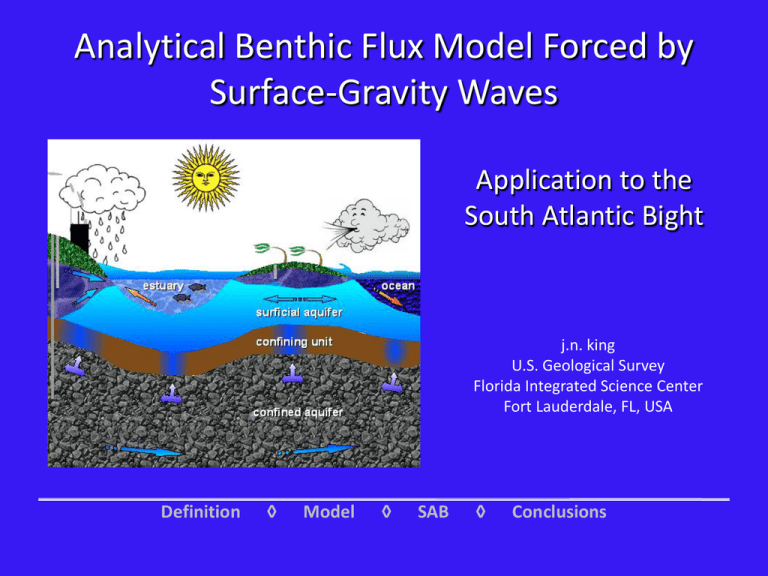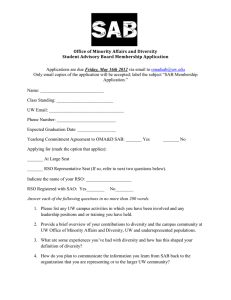Analytical Benthic Flux Model Forced by Surface-Gravity Waves Application to the
advertisement

Analytical Benthic Flux Model Forced by Surface-Gravity Waves Application to the South Atlantic Bight j.n. king U.S. Geological Survey Florida Integrated Science Center Fort Lauderdale, FL, USA Definition ◊ Model ◊ SAB ◊ Conclusions Definition :: Benthic Flux Benthic flux is the rate of flow of some quantity across the bed of a water body, per unit area of bed. Benthic flux is a vector quantity, where the vector is oriented normal to the bed. Benthic flux units are a function of the quantity under consideration: •volume quantity: L3 T-1 L-2 (=LT-1) •mass quantity: M T-1 L-2 Benthic flux is a transient process. Definition ◊ Model ◊ SAB ◊ Conclusions Definition :: Benthic Flux Benthic flux is the rate of flow of some quantity across the bed of a water body, per unit area of bed. Benthic flux is a vector quantity, where the vector is oriented normal to the bed. Benthic flux units are a function of the quantity under consideration: •volume quantity: L3 T-1 L-2 (=LT-1) •mass quantity: M T-1 L-2 Benthic flux is a transient process. Definition ◊ Model ◊ SAB ◊ Conclusions newer … Burnett et. al. (2003) older Also known as: • Seepage • Irrigation • Flushing • Ventilation • Percolation • Sub-tidal pump • Submarine ground water discharge (SGD) • Submarine ground water recharge (SGR) • Submarine pore water exchange (SPE) Benthic flux is independent of direction: •benthic discharge (flux): gw => sw •benthic recharge (flux): sw => gw Related processes: • Deposition & Resuspension • Bio-turbation • Bio-irrigation • Salt fingering • Fluidization of sediment in the surf zone Benthic flux is independent of water body: wetland, river, lake, estuary, lagoon, ocean Benthic flux is independent of location in the water body: surf zone, shelf, deep ocean Definition ◊ Model ◊ SAB ◊ Conclusions Processes that Drive Benthic Flux Definition ◊ Model ◊ SAB ◊ Conclusions +z Surface-Gravity Wave over Rigid, Porous Media 4Unknowns – 4Equations Assume z=0 +x ( x, z , t ) A cosh (h z ) B sinh (h z )e i ( x t ) ps ( x, z , t ) Ce k ( h z ) e i ( x t ) 1 (DFSBC) g t (KFSBC) w( x, z , t ) t p ( x, z h, t ) ps ( x, z h, t ) (DBBC) 2 0 ( x, z , t ) z=-h w( x, z h, t ) ws ( x, z h, t ) (KBBC) t w( x, z h, t ) z k ps ws ( x, z h, t ) z p ( x , z h, t ) ps 0 2 Definition ◊ Model ◊ SAB ◊ (Bernoulli) (velocity potential) (Darcy) Conclusions Reid & Kajiura (1957) u 0 k u p s Definition ◊ Model ◊ SAB ◊ Conclusions King, Mehta & Dean (2008?) Generalized Analytical Model for Benthic Water Flux Definition ◊ Model ◊ SAB ◊ Conclusions Moore (1999) Moore (1996) Definition ◊ Model ◊ SAB ◊ Conclusions Moore (1996) SAB Moore (1999) Estuaries 0.01 dpm/L A 226Ra = 0.19 dpm/L Ocean 0.08 dpm/L A 226Ra.Excess = 0.19-0.01-0.08 = 0.10 dpm/L VSAB.InS = 20km × 320km × 10m = 6.4×1013L Tresidence.226Ra = 30d Å 226Ra.Excess = 0.10×(6.4×1013)÷30 =2.1×1011dpm/d Definition ◊ Model ◊ SAB ◊ Conclusions Moore (1996) SAB Estuaries 0.01 dpm/L A 226Ra = 0.19 dpm/L 7 dpm/L Å 226Ra.Excess =2.1×1011dpm/d Pore Water QMoore=2.1×1011÷7 =3×1010L/d =350m3/s qMoore=0.5cm/d Definition ◊ Model ◊ SAB ◊ Conclusions Ocean 0.08 dpm/L Li and others (1999) • Three (nearshore) processes: – Tidal pumping on sloped beach • 130m3/s or 37%QMoore – Wave set up • 190m3/s or 54%QMoore – Terrestrial hydraulic gradient (from Younger,1996) • 14m3/s or 4%QMoore • Linear sum = 14+130+190 = 334m3/s or 95%QMoore Definition ◊ Model ◊ SAB ◊ Conclusions Application of Case I to SAB 1.4E-05 1.2E-05 shoaled and damped a [m /s] 1.0E-05 8.0E-06 6.0E-06 4.0E-06 2.0E-06 0.0E+00 0 500 1000 1500 distance offshore [m ] 99%Qbd .w bathymetry from Riedl et al. (1972) [m2] 3 [kg/m ] 2 [m /s] [s] [m] Qbd . w [m3/s] k u T a 1E-11 1030 1.17E-06 6.0 0.55 9475 Definition 5.5 0.50 8082 ◊ Riedl et al. (1972) canonical canonical Riedl et al. (1972) Riedl et al. (1972) 5.0 0.45 6582 Model ◊ SAB ◊ Conclusions 2000 2500 Moore & Wilson (2005) Moore & Wilson (2005) 7dpm/L? 1.3dpm/L 0.2dpm/L 0 Ra [dpm/L ] 0.5 10 Wave mixed zone 20 30 40 50 Definition ◊ Model ◊ SAB 1 0 depth [cm ] Martin et. al. (2006) 226 ◊ Conclusions 1.5 Updated Moore (1996) SAB Estuaries 0.01 dpm/L A 226Ra = 0.19 dpm/L Ocean 0.08 dpm/L Pore Water 0.5 0.19 7 dpm/L dpm/L dpm/L Pore Water QMoore= 2.1×1011÷0.3 = 7×1011L/d = 8100m3/s qMoore= 11cm/d Definition ◊ Model ◊ SAB ◊ Conclusions Conclusions • Waves matter! Surface gravity waves advect pore water constituents into surface waters. • Shelf-wide processes are probably larger contributors than near-shore processes. • Qbd . w= 8,100m3/s too large? What about bedform effects? Definition ◊ Model ◊ SAB ◊ Conclusions Future Work (?) • Wave mixed-zone: other forcing mechanisms transport pore water constituents onto the wave-mixed zone – Density gradients – Pressure gradients – Concentration gradients – Episodic gradients • Numerical model! Definition ◊ Model ◊ SAB ◊ Conclusions Questions?

